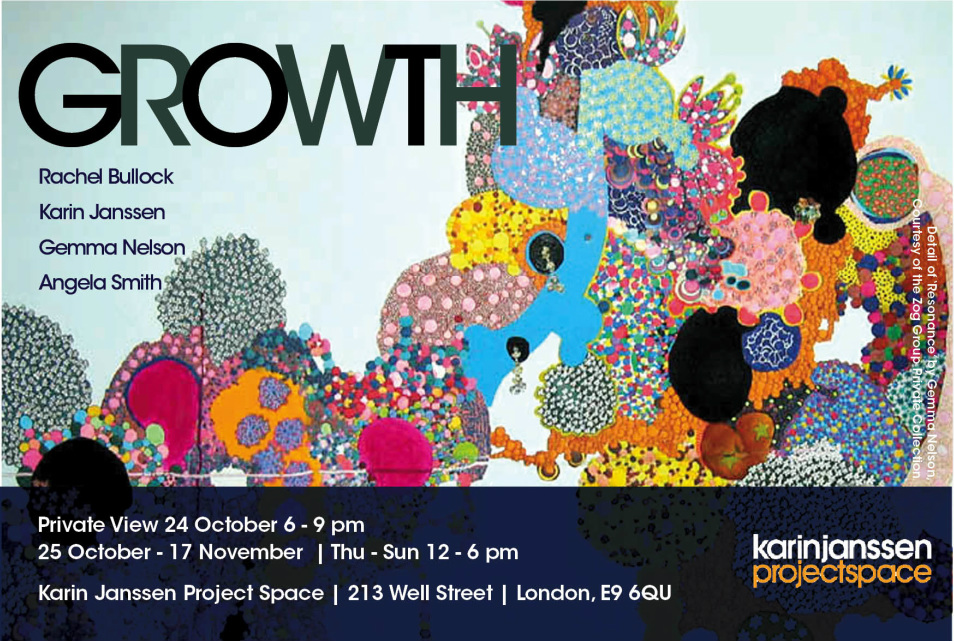Karin Janssen Project Space Exhibitions: GROWTH
|
GROWTH
RACHEL BULLOCK | KARIN JANSSEN | GEMMA NELSON | ANGELA SMITH
curated by Karin Janssen Thursday until Sunday 12 - 6pm, First Thursday 7 Nov until 9pm Private View Thursday 24 October 6 - 9pm Exhibition from 25 October until 17 November Press release“There are things in that paper that nobody knows but me, or ever will.”
― Charlotte Perkins Gilman, The Yellow Wallpaper, 1892 GROWTH brings together the work of four artists for whom the process of creating is seamlessly linked to the outcome of their work. They slowly let their work expand, listen to what the work wants and embrace an impulsive, organic process of creating, not afraid to let forms and composition grow intuitively and chaotically, trusting the work so much that they let it take over, let the work happen, and almost create itself. This process results in work in which the energy is tangible and in an exhibition of pieces we understand from the gut. Although working in traditional media like drawing and painting, the artists in GROWTH fall in between abstract and representational art: there are still realistic references present, but they use their artistic freedom to create their own strange worlds. They give rise to distorted, organic yet confident shapes, reaching the twilight zone where beauty meets ugliness and repulsion and attraction go hand in hand. At the base of these amorphous forms lie struggles from within the human psyche, personal stories, myths, fairy-tales, fantasy and sexuality. Gemma Nelson’s obsessively crafted cells weave together chaotic yet delicate tapestries, creating imaginary worlds that explore biological processes in structures of fungi, viruses and flowers. Highly obsessive and organic in construction, with an almost childlike sense of play and naivety, her distorted structures rise, the cells of colour bubbling and multiplying, the flatness of the indian ink floating amongst oozing enamel surfaces, only to keel over and collapse. Her working process is very labour-intensive and like the protagonist in Charlotte Perkins Gilman's 'The Yellow Wallpaper' Gemma seems to almost get swallowed up by the patterns in her own work. The paintings and drawings of Karin Janssen reveal an unsettling side to GROWTH. A ‘growth’, as a noun, especially used in the context of the physical body, reminds us of deformations and tumours, which we instinctively reject. Karin’s latest series of work ‘Silent Screams in the Valley of Uncanniness’ are at the same time uncomfortably strange and uncomfortably familiar, playing fool with our sense of familiarity, creating unsettling images where instincts are led astray and we are left abandoned in our own world of connotations and gut reactions. Not shying away from the abject, her work researches how crude emotions can alter the appearance of the physical body, causing one’s internal world to become externally visible by changing and transforming the body. A similar idea is explored by Angela Smith who looks to expose the unsaid, the hidden and the awkward, that what we learn to mask by protective, but inhibiting layers. She opens up the internal psyche, promoting honesty and true interaction, but revealing almost alien like creatures that at the same time intrigue and frighten us. Angela pours the paint onto the canvas, letting it run to create sinuous shapes, sags, wrinkles and furrows, an unpredictable process which matches the fragile vulnerability of her 'Creatures'. In Rachel Bullock’s monumental yet delicate charcoal drawing a ghostlike queen rises up in a tangle of fur coats, hair, mountains and waterfalls. This sentient but not quite human being seems to grow straight out of the earth. Inspired by her travels Rachel created a ghostly apparition of an other worldly tribal chief of the Nordic Highlands, melancholic and confusing, arousing the viewer’s curiosity to the hybrid being inside. The title 'Morand Lesovii' opens up the possibility of a more personal interpretation of the work, since although, suggesting a name in an exotic language, it can also be read as ‘more and less of I’. Knowing that, we all of a sudden become aware that we could be looking at a self-portrait. The artist’s psyche seems to transform the world around her, a world which at the same time is subjugating her and she is left sitting strong and proud, but overgrown by her own drawing. |
Selected press coverage
|




























